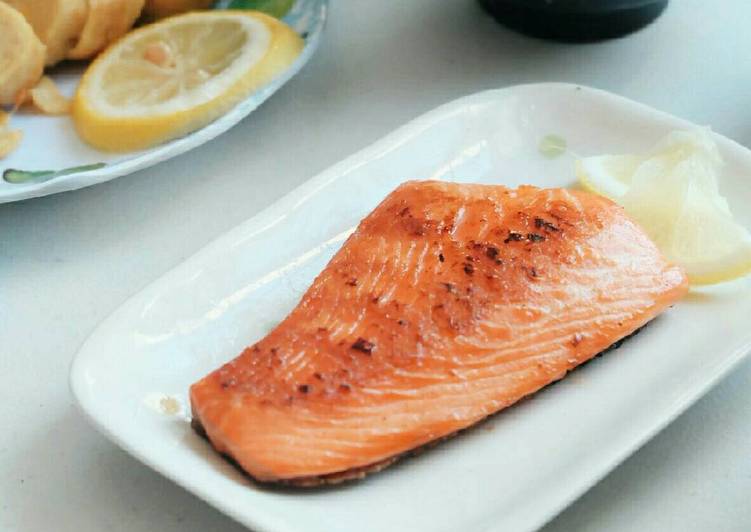Salt-Grilled Salmon (Salmon Shiozake). Salted salmon, or shiozake (often shortened to shake), is a staple of the Japanese breakfast table and has been since time immemorial. While salted salmon is readily available for purchase in Japanese supermarkets, it can be difficult to find in the United States. This recipe approximates the flavor and.
 Salted salmon is called 'shiozake' or 'shiojake' (塩鮭) in Japanese.
In Japan, you can buy sliced salted salmon fillets Grilled salted salmon made from standard salmon fillet served with a couple of boiled okra (ladies' fingers).
In the above photo of grilled salted salmon.
Salted salmon is called 'shiozake' or 'shiojake' (塩鮭) in Japanese.
In Japan, you can buy sliced salted salmon fillets Grilled salted salmon made from standard salmon fillet served with a couple of boiled okra (ladies' fingers).
In the above photo of grilled salted salmon.
Hey everyone, it is Louise, welcome to my recipe site. Today, I'm gonna show you how to prepare a distinctive dish, salt-grilled salmon (salmon shiozake). One of my favorites. For mine, I'm gonna make it a bit tasty. This will be really delicious.
Salted salmon, or shiozake (often shortened to shake), is a staple of the Japanese breakfast table and has been since time immemorial. While salted salmon is readily available for purchase in Japanese supermarkets, it can be difficult to find in the United States. This recipe approximates the flavor and.
Salt-Grilled Salmon (Salmon Shiozake) is one of the most well liked of recent trending foods in the world. It's simple, it's fast, it tastes yummy. It is enjoyed by millions daily. They're fine and they look fantastic. Salt-Grilled Salmon (Salmon Shiozake) is something that I've loved my whole life.
To get started with this recipe, we have to first prepare a few components. You can have salt-grilled salmon (salmon shiozake) using 4 ingredients and 9 steps. Here is how you cook that.
The ingredients needed to make Salt-Grilled Salmon (Salmon Shiozake):
- {Make ready of Salmon Fillet (with skin).
- {Get of Sake or Ryorishu (Cooking Sake).
- {Make ready of Kosher salt.
- {Take of Oil.
Shiozake (shio=salt, sake/zake=salmon) is grilled, salted salmon that is a very common dish for anytime of the day in Japan. It is often eaten for Other than finding salmon, cooking it is nothing to it. The salted flesh has a firmer. It's another way of eating Salmon : salted.
Instructions to make Salt-Grilled Salmon (Salmon Shiozake):
- Rinse salmon under cold water and pat dry using paper towel..
- In a container, pour sake over salmon, let it marinated for 10 minutes or so. Sake will help to eliminate the fishy smell in salmon..
- Using paper towel, pat salmon dry. Sprinkle generous amount of salt on both sides of salmon fillet, especially on the skin..
- Prepare a container with tight lid like this. Put paper towel inside, place the salmon fillet, then add another layer of paper towel on top. Close the lid..
- Keep in the fridge for at least 24 hours. The longer you keep, the saltier it will become..
- After 24 hours, take out the salmon. The paper towel should have been absorbing extra moisture from the salmon surface by now, so it will look somewhat dry. That's Ok.
- Prepare your frying pan. Pour just a little amount of oil, and grill the fish on both sides until the skin becomes crispy and the flesh turned into peachy color..
- Don't grill for too long, it will make the salmon texture gets hard & tough..
- If the salmon is ready, you can squeeze a bit of lemon juice on top if you like..
It is so yummy and always reminds me of traditional Japanese 'washoku' meals. You will like it too I hope. Place salmon on the preheated grill, and discard marinade. Be sure to use plain Lemon Pepper and not Lemon Pepper Seasoning Salt (you will oversalt if you do). If grilling is rained out, this can be baked.
So that's going to wrap it up with this exceptional food salt-grilled salmon (salmon shiozake) recipe. Thank you very much for your time. I am confident you will make this at home. There's gonna be more interesting food in home recipes coming up. Don't forget to bookmark this page in your browser, and share it to your family, friends and colleague. Thanks again for reading. Go on get cooking!
